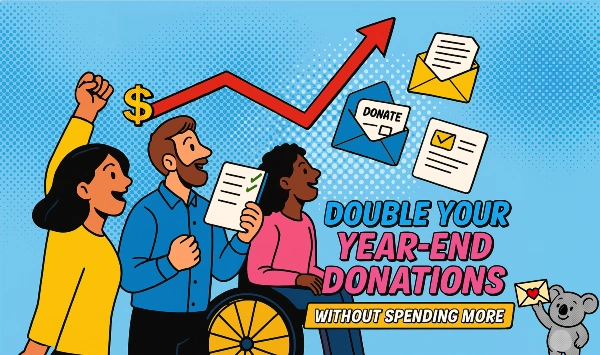Stories are hard.
Hard to find. Hard to tell well.
And especially hard to keep on task.
It’s that last one – keeping your story “on task” that so often trips up fundraisers.
Because the purpose of telling a story in fundraising is NOT…
- To show people you’re tackling a really big problem.
- Or to convince people that your organization is awesome.
- Or even to amaze them with the story and the people in it.
Fundraising stories should always be about the specific and wonderful way the donor is going to make the world a better place.
Here are four important principles for relevant (and successful) fundraising stories:
1. Need, not success
Your appeal has one job to do: Move donors to action.
That means you need to present them with a problem that they can help solve. And that means you need to focus on the thing that’s wrong – and what they the donor can do about it.
That means your story should show the need. Not a success.
This can be difficult for many nonprofit insiders. Because you are no doubt seeing success happening. And those successes are the whole reason for your organization’s existence. Those are the stories that make you and your colleagues feel good. They validate your hard work.
Why wouldn’t they motivate donors to give – to get more of this success to happen?
Because people are far more drawn to solving problems and making positive change than they are to becoming part of a status quo, even a very good one.
Here’s a success-focused story:
Sumita sits in the classroom, chanting her arithmetic sums with the other students. Her face glows with concentration and joy. Thanks to generous support and community partnerships, we established a scholarship fund, provided uniforms and supplies, and worked with local leaders to make education accessible for girls like Sumita. Finally, she knows her dreams of a better life are in reach.
It’s a good story. Really. But, as rewarding as it is, it doesn’t call for the donor to take action. The donor may like the story, and they may quietly congratulate your organization for making it happen.
But the donor isn’t needed in this scenario.
Here’s a need-focused story:
Sumita hovered outside the school. She could hear the children inside chanting their arithmetic lesson. She couldn’t understand what their words meant. A tear ran down her cheek. “I will never be able to go to school,” she thought, staring at the heavy water can that was her job to lug back and forth every day.
This leads your donor toward action! It’s clear something needs to be done – and the following paragraphs will tell her exactly what that action is, and how she can make it happen.
The success story is important. You should be telling it.
But not while you’re asking donors to give. That should be part of your thanking and reporting back.
2. Simple, not complex
Life is complicated. The more you know about a situation, the more you grasp the complexity and know that solutions need to take the complexity into account.
But that’s not good fundraising storytelling.
Sumita belongs to the Toda ethnic group, who migrated into the area about a hundred years ago, and are widely discriminated against because they are seen as unfair beneficiaries of help from the colonial powers. This, along with the sustained drought and crumbling infrastructure, is one of the reasons for her poverty.
Is all that background important? YES! If your organization is competent, you are all over those things.
But those details don’t help move donors to action. Every extra fact you include in the story is one more thing the donor has to consider and digest. And your donor doesn’t have the time or energy for that.
Here’s a simpler, more focused way to tell the story, so it only includes the details needed for the story to be clear:
Sumita is hungry. Again. It hasn’t rained since last October, and the crops withered in the ground. She’s tried to get work in the town, but nobody will hire her.
Keep the story as simple as possible. Name as few people as you can. Focus in on one part of the problem – the one you want the donor to help make possible.
Also, usually, it’s better to keep the story short.
3. Reader inclusive
Fundraising stories that move people to action aren’t just accounts of things other people did, like journalism. Our stories include the potential donors. We are inviting them to step into the stories we tell and become part of them.
That means finding ways to inject the reader into the story. This is pretty simple to do. Here’s an example of a story without the reader in it:
Before Sumita can even think about going to school every morning, she has to fetch the water. That’s a three-mile walk each way. It takes about an hour. But Sumita knows her mother needs the help. So she’s late for school most days. That interferes with her education.
Not bad, but the reader isn’t invited in. Here’s how you could tell that same story, but include the reader:
I wish you could meet Sumita. She has such an amazing attitude. I don’t know how she keeps it up, having seen what she goes through day after day. She works hard in school, but before she goes every morning, she has to fetch the water. That’s a three-mile walk each way. It takes about an hour. That makes her late for school most days, and you can see how that interferes with her education. She isn’t asking for help. But I know you would love to help her transform her life….
Same story, but it is oriented to the reader becoming part of the story.
Here are some more ways to bring the reader into the story:”
- Speak the reader’s language. Studiously avoid professional jargon and terms not likely to be familiar to non-experts.
- Compliment the donor. Donors are special people who are already doing more than their “fair share.” Tell them you know that about them!
- Recognize the donor’s situation. Like everyone, donors are busy, and often facing difficult situations of their own. Also, they get a lot of fundraising! Show them you understand by saying things like “I know you get a lot of requests for funds. That’s because you are a generous person. But if you could take just a moment to write a check…”
- Give donors permission not to give. They have the power to ignore you or say no to your requests. Show them you recognize that: “I realize now might not be the right time for you to give. Please don’t feel pressured in any way!”
- “Preview” what their giving will accomplish. Don’t tell stories of already-accomplished success, but do describe what will happen when they give. Donors need hope that their giving makes a difference.
4. Readable
One of the most welcoming things you can do for your donors is make your materials easy to read. This comes from the way you write and they way you design the writing. Here’s what to aim for:
- Good readability scores. That means short sentences, and as few long words as possible. The easier copy is to read, the more it gets read … and the more it gets acted on.
- Short paragraphs in varying lengths.
- Visual emphasis, including underlining, bold, italics, subheads – things that draw the eye.
- Wide margins and plenty of white space.
- Black type over white backgrounds. Avoid type in any other color, and don’t put type over colored backgrounds.
- Large fonts. 12 point type, preferably larger.
- Serif fonts in print, sans-serif for screens.
Donors, like everyone, can sense when they are welcome. Messages that are hard to read clearly signal a lack of interest in them.
Fundraising is a challenging career – but one of the best lives you can choose. To help you advance your career in a proven, logical, experience-based way, we’ve created a new Starter Guide for Your Fundraising Success Path. Download it now and you’ll start your journey to mastery and success in the best career on Earth!
Please share your experience by leaving your reply below. We’d love to learn from your experience.












1 Comment. Leave new
Thank you for capturing the essence of effective and compelling storytelling for nonprofits, Jeff! I so appreciate your guidance and common-sense approach.